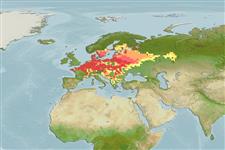Classification / Names
Common names | Synonyms | Catalog of Fishes (gen., sp.) | ITIS | CoL | WoRMS | Cloffa
Environment / Climate / Range
Ecology
Freshwater; brackish; demersal; potamodromous (Ref. 51243). Temperate; 4°C - 25°C (Ref. 1672), preferred ?; 62°N - 42°N, 15°E - 61°E
Europe and Asia: In Europe, north of the Alps, from Meuse eastward to Neva drainages and Lake Ladoga; northern Black Sea basin from Danube eastward to Kuban, absent on the southern section; Caspian basin in Volga and Ural drainages. Not native to Great Britain, Scandinavia, Apennine and Iberian peninsulas, Crimea, and Adriatic, Aegean and White Sea basins. Locally introduced in Rhône drainage (France) and perhaps elsewhere (Ref. 59043).
In Appendix III of the Bern Convention (protected fauna) (Ref. 1441).
Length at first maturity / Size / Weight / Age
Maturity: Lm ?, range 11 - ? cm
Max length : 30.0 cm TL male/unsexed; (Ref. 556); 30.7 cm TL (female); common length : 15.0 cm TL male/unsexed; (Ref. 556)
Short description
Morphology | Morphometrics
Found in lower reaches of slow-flowing rivers, but can also be found in still pools (Ref. 9696), on sandy bottoms of ponds, pools and ditches. Adults are nocturnal which burrow into mud during dry periods and strong frosts. Usually, burrows are 20-30 cm deep, occasionally down to 70 cm during dry periods (Ref. 59043). During the day, they stay buried in the sand. Feed on insect larvae and small mollusks. Seldom captured with hook and line (Ref. 30578). Are sensitive to pollutants which accumulate in the sediment (Ref. 11941). Facultative air-breathers (Ref. 27368). A female specimen measuring 30.7 cm TL was recorded from Netherlands (Ref. 114650).
Male follows female into dense vegetation and forms a complete ring around her body, behind dorsal fin (Ref. 59043).
Kottelat, M. and J. Freyhof, 2007. Handbook of European freshwater fishes. Publications Kottelat, Cornol and Freyhof, Berlin. 646 pp. (Ref. 59043)
IUCN Red List Status (Ref. 115185)
CITES (Ref. 94142)
Not Evaluated
Threat to humans
Harmless
Human uses
Fisheries: of no interest; bait: usually
More information
ReferencesAquacultureAquaculture profileStrainsGeneticsAllele frequenciesHeritabilityDiseasesProcessingMass conversion
Tools
Special reports
Download XML
Internet sources
